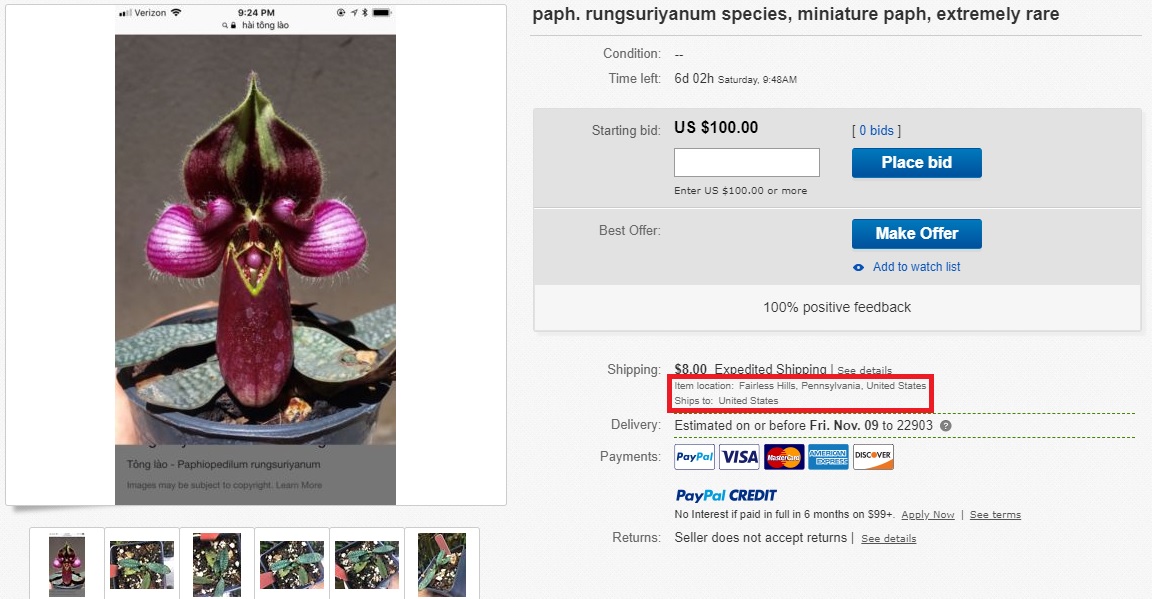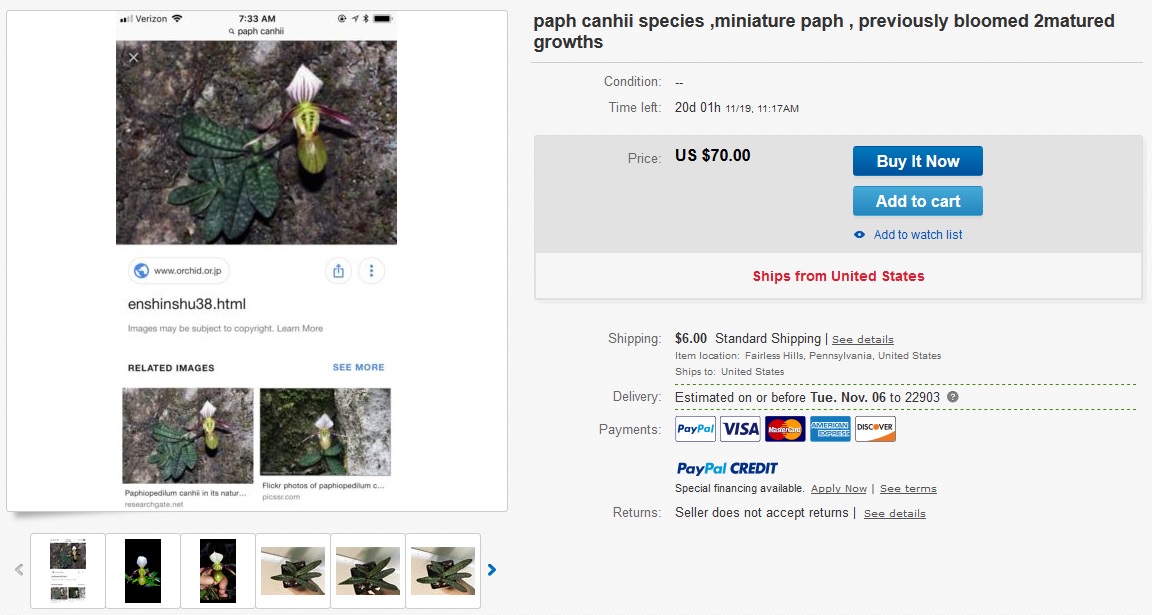Well, maybe they did get the message...
I hadn't sent them anything about the canhii listing yet, but I did notice that they took it down pretty quickly due to "an error in the posting"
...shortly after removing the posting, they sent me another message -
"Dear Sir
I just to say thank you again to remind me about the law so I can avoid unnecessary trouble. I appreciated your help.
I am also a new hobby seller so I didn’t have much experience. I saw them (nursery in Vietnam) growing the plants so I assume it was legal but I was not sure if they have legal paper for it. There specy is so rare that they are not available for sale if people didn’t propagate them.
I am requesting the company where The plants was from, to provide papers and CITES for their parent plants, in the mean time I will remove the ad
It will be only posted when I have legal papers to avoid hassle for my buyers
Again, I appreciate your help"
Optimistic, but misguided since I highly doubt any export permits exist for these really new species...
However, I responded -
"No problem! This hobby definitely has a steep learning curve. If you could get legal export/import permits for these plants, then it would be wonderful to see them introduced into the US (I am afraid that export documents may not exist for the really new species though). I know a lot of people would be interested in buying them if they were brought over legally. I wish you all the best with your orchid growing/selling endeavors."
Hopefully that is the end of it...
I believe the explanation about the propagation statement the person made "that the species is rare enough that peoples propagate them", if you read this old article posted 7 or 8 years ago, it seems to already confirm the rarity at the time.
The minority highlanders when they go out hunting in the forest etc for their own food supply, if they see a plant, a bulb, an animal whatever, that they think someone would be interested in purchase , they will bring it back, it not necessary be an orchid ( the chinese herbalists bought many precious herbs from Vietnam for dirt cheap for this reason, there are times, when the highlanders did not know much about the real value of the plants, the chinese came in and bought literally tons of orchids for practically the price of a cup of coffee in the US ) orchids from the forest to sell to anyone is common place, there are road side stands, I can find some you tube (however they are in Vietnamese).
Also the collectors & nurseries in Vietnam do not raise any things in green houses close environment insect proof, fungus free, virus free such as gigantic operation in Taiwan, Holland .
All expose to natural environment, rain or shine, sometimes just hanging on trees.
The better ones may be have fenced space and maybe some screen overhead, that is all .
Don't expect anything look pristine and unblemished . I doubt anyone can tell whether a plant is propagated or bought from the highlanders. Either of them would look better in the hand of someone who baby the plants. The more natural they raised , the stronger yet tattered they look (compare a farmer in the midwest, a fisherman down in Louisiana & the Upper west side NYC person and you get the idea) They don't grow orchids inside the house the way we do here.
This is an old STF article:
http://www.slippertalk.com/forum/showthread.php?t=21670
I thought the extract below may be of interest. The full report (22p) can be found on the Rufford website.
ASSESSMENT OF DISTRIBUTION AND NATURAL STATUS OF PAPHIOPEDILUM CANHII, VIETNAM
First information about existence of Paphiopedilum canhii come from northwestern Vietnam. In fact P. canhii was firstly observed in sale on local markets in Dien Bien and Son La cities. This fact with high probability indicates northwestern part of Vietnam in limits of Dien Bien and Son La provinces, as well as allied regions of Laos as most probable native area of the species.
Paphiopedilum canhii was described on the base of few plants that were brought from remote mountain area at the end of 2009 by H’Mong (Meo) people to office of “Civilian Governmental Service for Care of Natural Resources and Connections with Local Minorities” (Natural Resources Governance, CARE International in Vietnam). At the office, plants were received by Service Officer – Mr. Chu Xuan Canh, who kept plants for further study and description.
Regrettably all discovered and studied subpopulations to moment of our exploration were already tragically depleted by commercial collecting. In our studies during December 2010 was found no one intact colony. Absolute majority of colonies in all 5 subpopulations were extinguished completely and only occasionally in most inaccessible cliffs were observed poor remains in form of single commonly depressed or juvenile specimens (Fig. 37-50). Plants were exactly collected just recently, certainly few months before our studies and many cliffs still retained numerous sad traces of former majestic species abundance. Very rarely few remained mature plants were observed in places of former many numbered colonies. Proportion of such plants may reach 30% (Fig. 55). However this is alone observed example. In all other cases plants are eliminated from colonies on 99 to 100% (Fig. 51-54). Total extinction of plants during 2009-2010 year may be estimated as at least 99%. At the same time the number of surviving mature (flower-sized) specimens in all subpopulations hardly exceeds presently 0.01% of former species population. Such unique relicts are presented on Fig. 38-50. As commercial collecting still can not be stop immediately, these are, probably, last photos of P. canhii in nature.
Hard exploitation of Paphiopedilum canhii started immediately after its discovery in middle of 2009 year. Most probably species was at first found by H’Mong (Meo) local people and collected along with other orchids for their regular sale in local markets of Dien Bien and Son La cities. Very distinct unusual slipper orchid was highly valued by local orchid lovers and fanciers just immediately after its appearance in orchid market. In few weeks rumours on intriguing new species speeded widely reaching Ha Noi and other large cities of northern Vietnam. First flowers of mysterious plant were open at the beginning of 2010 in a number of private collections in Ha Noi, Dien Bien and Son La cities. At this moment become clear that orchid society met one more new exciting slipper orchid species. Next days internet was filled with images of new flower.
At this time price for flowering plants reached its maximum. Illustrated publication of new species in world-known American Orchid Society Magazine also activated market demands and supported fast cost rise. Additionally, participation in the trade of foreign dealers provided much highest influence to the market price dynamics. Numerous international dealers arrive in spring 2010 to Son La and Dien Bien cities for trading. Best plant clones at this time were traded by costs up to 100 USD for alone plant. Largest lots of plants were supposedly imported to Taiwan.
Strong rumours about high prices for plants provoked true orchid fever in the area of Paphiopedilum canhii. All people from neighboring villages layaway their each day home duties and come to the forest looking for a plants. In some days more than 20 people collected plants in dream to sell them for high price. Naturally high supply of plants on the market for sale, immediately exceeded demands. Very soon after plant flowering period price come down to 100 and then 50 USD per kg.
To the end of 2010 the cost was only 10-20 USD for 1 kg, but even for these costs trade was very weak and most not sold plants were simply trashed. Ironically the collecting of great majority of plants was fruitless. They bring no money to local people, no profit to local or international trade, no happiness to orchid lovers all over the world. These last specimens of unique critically endangered species that stands on verge of full extinction were simply wasted (Fig. 151). Low level of horticulture and lack of necessary experience in slipper orchid cultivation permit no long cultivation P. canhii in local collections and nurseries. So even large flowering size plants actually have no chance to survive in conditions of primitive agriculture (Fig. 151-154). To the end of 2010 trade of P. canhii actually completely exhausted due to 3 main reasons: - no more demands from foreign dealers (they already bought best clones necessary for propagation and breeding); - no more demands from domestic purchasers (due to hard difficulties in plant cultivation in primitive conditions); - very few plants in nature (that make their search and collecting unprofitable).
According to very approximate estimation 25-35 kg of P. canhii samples were collected during short history of its discovery, exploitation and extinction. Plants are fairly small when 1 kg contains about 300-350 mature (flowering-size) plants and commonly 200-300 offspring juvenile samples. Following to these calculations totally were collected at least 10.000-15.000 mature and juvenile specimens. Direct observation in nature indicates that about 99.5% of populations were extinguished in one year of exploitation. In our opinion species has no chance survive in nature. It is particularly true taking into consideration fast deforestation in its small native area.
The Rufford Small Grant Foundation
Leonid V. Averyanov
Regards. Mick
If we live in Vietnam we will not made a statement that " the orchid plant is illegal" (I don't think any orchid in Vietnam is illegal), it does not make any sense over there. besides, for a nursery over there to get what ever paper to satisfy the West would make no sense to them , let say the 1 dollar is the cost for 1 kg of orchids, and the paper work is 20 dollar or more .
 ).
).





